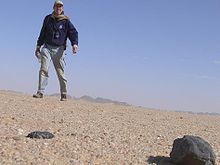- Peter Jenniskens
-
Peter Jenniskens 
Peter Jenniskens in the Nubian Desert, February 2009Residence Mountain View, CA, USA Education M.S. Leiden University (1988)
Ph.D. Leiden University (1992)Occupation Astronomer, Explorer
SETI Institute
NASA Ames Research CenterPetrus Matheus Marie (Peter) Jenniskens (born August 2, 1962 in the Netherlands) is a Dutch astronomer and a senior research scientist at the Carl Sagan Center of the SETI Institute and at NASA Ames Research Center.[1] He is an expert on meteor showers. Jenniskens is the author of the 790 page book "Meteor Showers and their Parent Comets" published by Cambridge University Press in 2006.[2] Jenniskens is chair of the Working Group on Meteor Shower Nomenclature of Commission 22 of the International Astronomical Union (2006–2012).[3] Discovered at Ondřejov Observatory by Petr Pravec, asteroid "42981 Jenniskens" is named in his honor.
In 2008, Jenniskens together with Muawia Shaddad, lead a team from the University of Khartoum in Sudan that recovered fragments of asteroid 2008 TC3 in the Nubian Desert, marking the first time meteorite fragments had been found from an object that was previously tracked in outer space before hitting Earth.[4][5]
Contents
NASA Multi-Instrument Aircraft Campaigns
Meteor showers
Jenniskens is the principal investigator of NASA's Leonid Multi-Instrument Aircraft Campaign (Leonid MAC), a series of four airborne missions that fielded modern instrumental techniques to study the 1998 - 2002 Leonids meteor storms.[6] These missions helped develop meteor storm prediction models, detected the signature of organic matter in the wake of meteors as a potential precursor to origin-of-life chemistry, and discovered many new aspects of meteor radiation.
More recent meteor shower missions include the Aurigid Multi-Instrument Aircraft Campaign (Aurigid MAC), which studied a rare September 1, 2007, outburst of Aurigids from long-period comet C/1911 N1 (Kiess),[7] and the Quadrantid Multi-Instrument Aircraft Campaign (Quadrantid MAC), which studied the January 3, 2008, Quadrantids.[8]
Jenniskens identified several important mechanisms of how our meteor showers originate. Since 2003, Jenniskens identified the Quadrantids parent body 2003 EH1, and several others, as new examples of how fragmenting comets are the dominant source of meteor showers.[9] These objects are now recognized as the main source of our zodiacal dust cloud.[10] Before that, he predicted and observed the 1995 Alpha Monocerotids meteor outburst (with members of the Dutch Meteor Society), proving that "stars fell like rain at midnight" because the dust trails of long-period comets wander on occasion in Earth's path.
Spacecraft reentries
His research also includes artificial meteors. Jenniskens is the principal investigator of NASA's Genesis and Stardust Entry Observing Campaigns to study the fiery return from interplanetary space of the Genesis (Sep. 2004) and Stardust (Jan. 2006) sample return capsules.[11] These airborne missions studied what physical conditions the protective heat shield endured during the reentry before being recovered.
More recently, Jenniskens led a mission to study the destructive entry of ESA's Automated Transfer Vehicle "Jules Verne" on 29 September 2008 [12] and the beautiful reentry of JAXA's Hayabusa probe over Australia on 13 June 2010.[13] An overview of ongoing missions can be found at: [1].
2008 TC3 fragments recovery
The recovery of fragments of asteroid 2008 TC3 marked the first time fragments had been found from an object that was previously tracked in outer space before hitting Earth.[4] This search was led by Peter Jenniskens and Muawia Shaddad of the University of Khartoum in Sudan, and carried out with help from students and staff of the University of Khartoum. The search of the impact zone began on December 6, 2008 and turned up 24 pounds (11 kg) of rocks in about 600 fragments.[4][5][14]
Other research
In earlier collaborations, he discovered that an unusual viscous form of liquid water can be a common form of amorphous ice in comets and icy satellites (during a post-doc study with David F. Blake) and he created the first broad detection-limited survey of Diffuse Interstellar Bands in his PhD thesis work with Xavier Désert.
References
- ^ Career pages of astronomer Dr. Peter Jenniskens
- ^ Jenniskens P., Meteor Showers and their Parent Comets. Cambridge University Press, Cambridge, U.K., 790 pp.
- ^ IAU Meteor Data Center
- ^ a b c "NASA Team Finds Riches in Meteorite Treasure Hunt". NASA. 2009-03-27. http://www.nasa.gov/topics/solarsystem/features/asteroid_treasure_hunt.html. Retrieved 2009-04-05.
- ^ a b P. Jenniskens et. al. (2009-03-26). "The impact and recovery of asteroid 2008 TC3". Nature 458 (7237): 485–488. Bibcode 2009Natur.458..485J. doi:10.1038/nature07920. PMID 19325630. http://www.nature.com/nature/journal/v458/n7237/abs/nature07920.html. Published in Letters to Nature
- ^ "NASA's Leonid Multi-Instrument Aircraft Campaign Homepage". NASA. http://leonid.arc.nasa.gov.
- ^ "The NASA Aurigid Meteor Shower Observing Campaign". SETI Institute. http://aurigid.seti.org.
- ^ "The NASA Quadrantid Meteor Shower Observing Campaign". SETI Institute. http://aurigid.seti.org.
- ^ Leonid MAC '99 - News on the Leonid shower
- ^ "Cometary Origin of the Zodiacal Cloud and Carbonaceous Micrometeorites. Implications for hot debris disks". Astrophysical Journal Vol. 713 (April 20, 2010). http://iopscience.iop.org/0004-637X/713/2/816. Retrieved 20-04-2010.
- ^ "The Stardust SRC Entry Observing Campaign". NASA. 2009-05-22. http://reentry.arc.nasa.gov. Retrieved 2009-05-22.
- ^ "The ATV-1 Jules Verne Multi-Instrument Aircraft Campaign". SETI Institute. http://atv.seti.org.
- ^ "The Hayabusa Re-Entry Multi-Instrument Aircraft Campaign". SETI Institute. http://airborne.seti.org/hayabusa/.
- ^ "The Impact and Recovery of 2008 TC3". SETI Institute. http://asima.seti.org/2008TC3/.
Categories:- 1962 births
- Living people
- Dutch astronomers
- Planetary scientists
- Leiden University alumni
Wikimedia Foundation. 2010.
